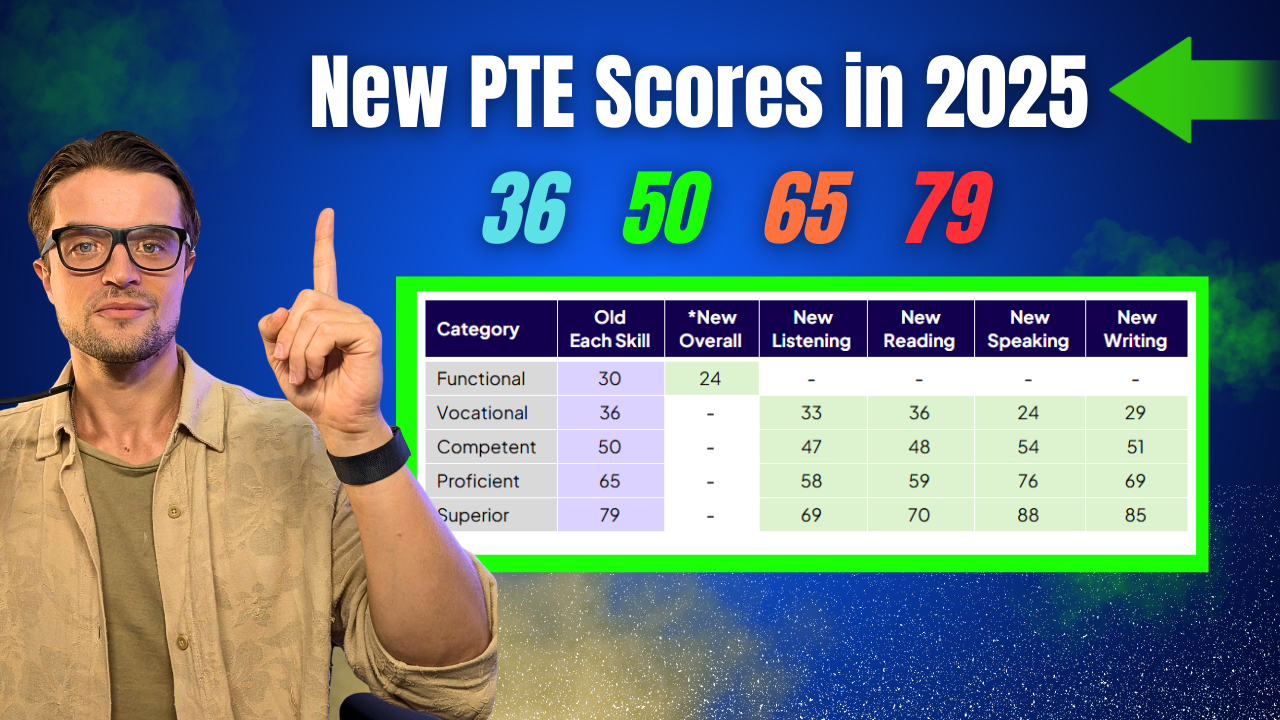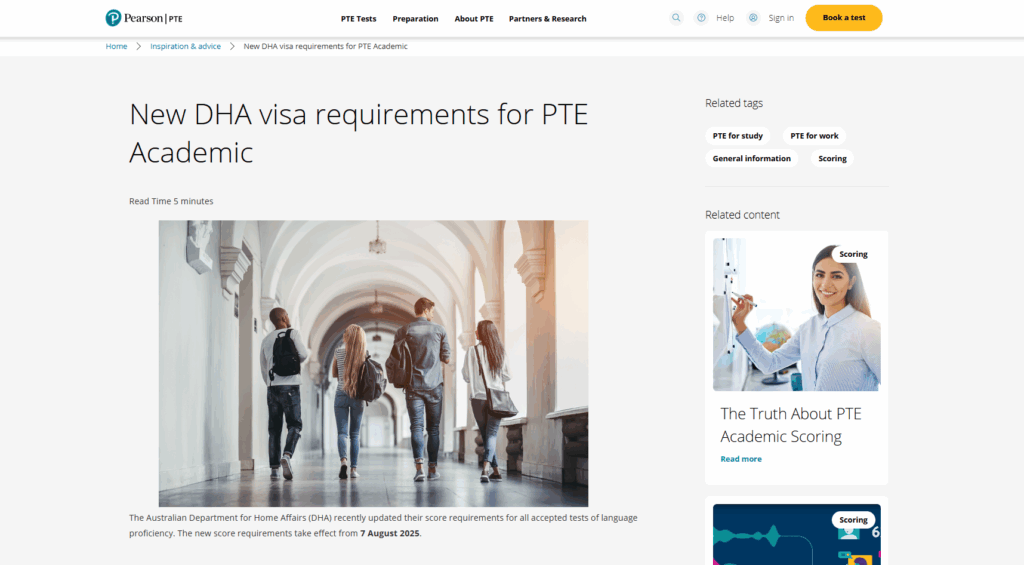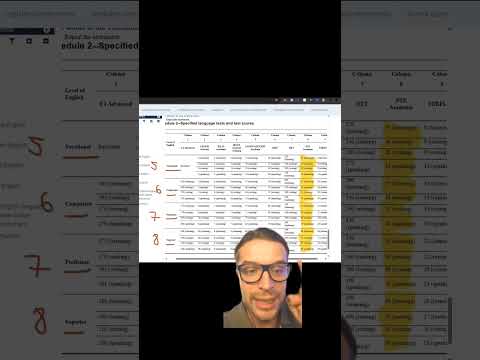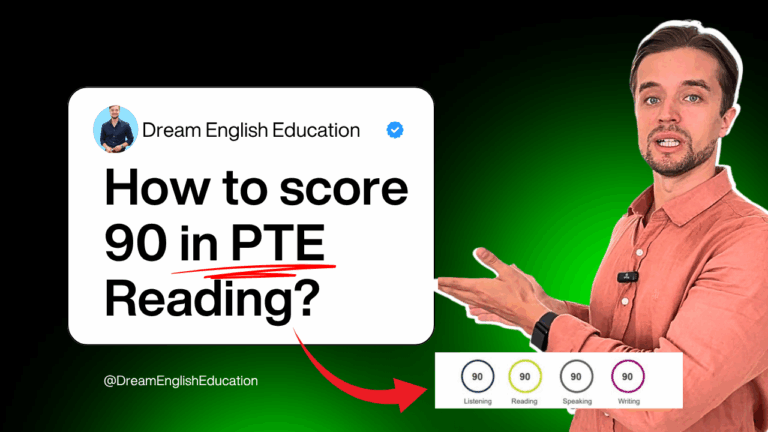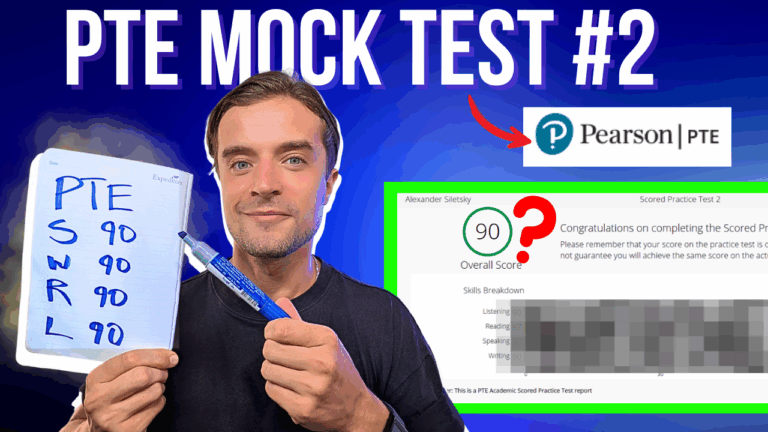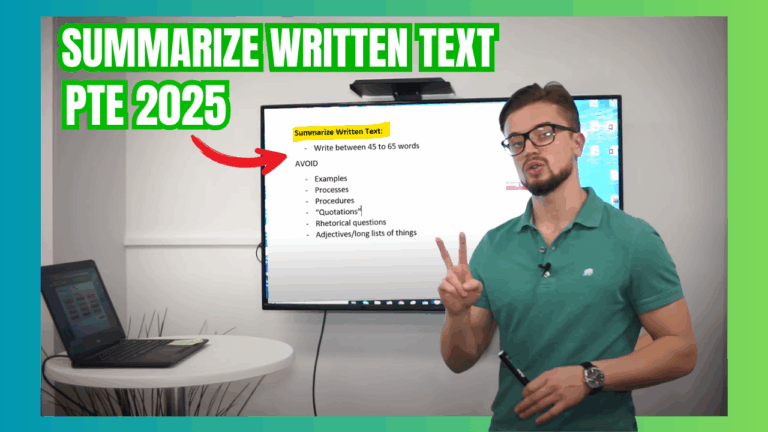The NEW Rules for 65 in PTE & 79 in PTE – (Australia Immigration PTE Score Changes)
Australia Immigration PTE score changes have completely transformed what it means to achieve your target score for visa applications. If you’re wondering “is it hard to get 65 in PTE” or “how to score 65 in PTE Academic” after the recent PTE requirement changes, you’re not alone. Hey guys, Alex here, and today I’m going to break down everything you need to know about the massive PTE new pattern 2025 changes that took effect on August 7, 2025.
These changes have left thousands of students confused, and we’ve been getting non-stop messages asking:
“What does 65 in PTE mean now?” and “Is 65 PTE easy to score?”
The answer might surprise you – in some ways, it’s actually become easier, but in others, it’s gotten harder (BUT we can overcome it).
If you’re planning to migrate to Australia or apply for any visa that requires English proficiency, this article will save you months of confusion and potentially thousands of dollars in unnecessary retakes. The Australia immigration PTE score changes aren’t just minor adjustments – they’re a complete overhaul of how PTE scores are evaluated for visa purposes.
Most migration agents and even some PTE coaches don’t fully understand yet: 65 points in PTE no longer means what it used to mean.
The old system where you needed 65 in each skill for Proficient level? Gone.
The new system is completely different, and if you don’t adjust with the New PTE Strategies, you’re going to struggle to pass PTE.
What Exactly Changed on August 7, 2025? (The Complete Breakdown)
The Australian Department of Home Affairs (DHA) completely restructured their English language requirements for all visa categories. This wasn’t a minor tweak – this was a fundamental change in how 65 in PTE means what level of English proficiency you’ve demonstrated.
Before August 7, 2025, the system was simple but harsh. If you wanted Proficient level (equivalent to IELTS 7), you needed exactly 65 in every single skill: Listening, Reading, Speaking, and Writing. Miss even one skill by one point? You’d get Competent level instead. It was an all-or-nothing system that frustrated thousands of test-takers.
The 79 in PTE requirement was even more brutal. For Superior level (IELTS 8 equivalent), you needed 79 in absolutely every skill. No exceptions, no flexibility. I’ve seen brilliant students with 85+ in three skills fail to get Superior level because they scored 78 in one area.
But here’s where it gets interesting with the PTE new pattern 2025: the Australian government realized this system was unnecessarily harsh and didn’t accurately reflect real-world English proficiency. So they commissioned Pearson to conduct a massive research study involving 1,522 participants to create a more nuanced scoring system.
The result? PTE requirement changes that are more realistic and, in many cases, more achievable. But there’s a catch – and it’s a big one.
The New Score Requirements: What 65 Points in PTE Actually Means Now
Here are the Australia immigration PTE score changes: 65 points in PTE as a uniform requirement no longer exists. Instead, each skill has its own specific requirement based on extensive research into how different language skills correlate with real-world proficiency.
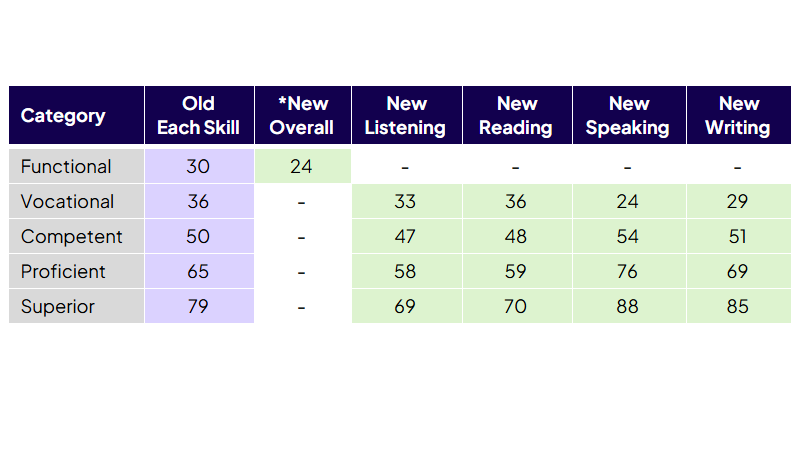
For Proficient Level (Old IELTS 7 Equivalent):
Listening: 58 points (down from 65)
Reading: 59 points (down from 65)
Speaking: 76 points (UP from 65!)
Writing: 69 points (up from 65)
For Superior Level (Old IELTS 8 Equivalent):
• Listening: 69 points (down from 79)
• Reading: 70 points (down from 79)
• Speaking: 88 points (UP from 79!)
• Writing: 85 points (up from 79)
Do you see the pattern here? Speaking requirements have increased dramatically, while Listening and Reading have become more achievable. This reflects what we’ve always known in the PTE coaching world: Speaking is the most challenging skill for non-native speakers, and the old system was undervaluing this difficulty.
For Competent Level (Old IELTS 6 Equivalent):
• Listening: 47 points (down from 50)
• Reading: 48 points (down from 50)
• Speaking: 54 points (up from 50)
• Writing: 51 points (up from 50)
For Vocational Level (Old IELTS 5 Equivalent):
• Listening: 33 points (down from 36)
• Reading: 36 points (same as before)
• Speaking: 24 points (down from 36!)
• Writing: 29 points (down from 36)
The Vocational level changes are particularly interesting – Speaking requirements actually decreased significantly, making this level much more accessible for trades and vocational visa applicants.
Is It Hard to Get 65 in PTE? The Truth About the New Requirements
The question “is it hard to get 65 in PTE” has become much more complex after the PTE requirement changes. The honest answer is: it depends entirely on which skill we’re talking about and what visa category you’re targeting.
If you’re aiming for Proficient level (the old 65 requirement), here’s the reality:
It’s become EASIER for Listening and Reading. Instead of needing 65 in both skills, you now need 58 in Listening and 59 in Reading. That’s a 7-point and 6-point reduction respectively. For many students, this is the difference between passing and failing.
It’s become HARDER for Speaking and Writing. Speaking jumped from 65 to 76 – that’s an 11-point increase! Writing went from 65 to 69, a 4-point increase. These aren’t small adjustments; they’re significant hurdles that will require different preparation strategies.
Let me put this in perspective with a real example. I had a student last month who scored 62 Listening, 61 Reading, 78 Speaking, and 71 Writing under the old system. This would have given him Competent level because he didn’t reach 65 in Listening and Reading.
Under the PTE new pattern 2025, this same score profile would give him Proficient level! His 62 Listening exceeds the new 58 requirement, his 61 Reading exceeds the new 59 requirement, his 78 Speaking exceeds the new 76 requirement, and his 71 Writing exceeds the new 69 requirement.
But here’s the flip side: another student who previously scored 68 in all skills (which gave her Proficient level) would now only achieve Competent level because her 68 Speaking falls short of the new 76 requirement.
How to Score 65 in PTE Academic: Updated Strategies for 2025
The question “how to score 65 in PTE Academic” needs to be completely reframed after the Australia immigration PTE score changes. You’re no longer aiming for a uniform 65 – you’re aiming for skill-specific targets that vary dramatically.
For Proficient Level Success (New Requirements):
Listening Strategy (Target: 58): This is now your “easiest” skill to achieve Proficient level. Focus on Summarize Spoken Text, Multiple Choice questions, and Fill in the Blanks. The 7-point reduction means students who previously struggled with 65 can now achieve their target with focused practice on high-scoring question types.
Reading Strategy (Target: 59): Similar to Listening, this 6-point reduction makes Proficient level much more achievable. Concentrate on Multiple Choice Single Answer, Re-order Paragraphs, and Fill in the Blanks. Time management becomes crucial – don’t get stuck on difficult passages.
Speaking Strategy (Target: 76): This is where the PTE new pattern 2025 becomes challenging. An 11-point increase means you need near-perfect performance in Read Aloud, Repeat Sentence, and Describe Image. Fluency and pronunciation are now more critical than ever. You cannot afford to have hesitations, false starts, or unclear pronunciation.
Writing Strategy (Target: 69): The 4-point increase means your essays need to be more sophisticated. Focus on complex sentence structures, advanced vocabulary, and flawless grammar. Summarize Written Text becomes even more important as it contributes to both Reading and Writing scores.
The New Reality: You can no longer rely on being “good enough” across all skills. The PTE requirement changes mean you need to be strategic about where you invest your preparation time. If you’re naturally strong in Listening and Reading, you can focus more energy on Speaking and Writing where the bars have been raised.
Is 65 PTE Easy to Score? The Honest Assessment
After working with thousands of students through these Australia immigration PTE score changes, I can give you an honest answer to “is 65 PTE easy to score?”
The short answer: It’s become easier for some students and harder for others, depending on your natural strengths and weaknesses.
It’s easier if you:
• Have strong listening comprehension skills (7-point reduction to 58)
• Are a fast, accurate reader (6-point reduction to 59)
• Struggle with speaking but are solid in other areas
• Have been consistently scoring in the 58-65 range in Listening/Reading
It’s harder if you:
• Have speaking anxiety or pronunciation issues (11-point increase to 76)
• Struggle with writing complex sentences (4-point increase to 69)
• Were previously achieving Proficient level with balanced 65+ scores
• Rely heavily on Speaking scores to boost your overall performance
The PTE new pattern 2025 has essentially created a more realistic but specialized scoring system. It acknowledges that different language skills require different levels of proficiency for real-world success, but it also means you can’t coast on your strongest skill anymore.
Here’s what I tell my students: if you were consistently scoring 60-64 in Listening and Reading but struggling to hit 65, the new system is your friend. But if you were relying on strong Speaking scores to compensate for weaker Reading/Listening, you’ll need to completely restructure your preparation strategy.
The 79 Score Reality: What Superior Level Means Now
The changes to the 79 score requirement are even more dramatic than the Proficient level adjustments. If you’re targeting Superior level for maximum migration points, the PTE requirement changes have created both opportunities and significant challenges.
New Superior Level Requirements:
• Listening: 69 (down 10 points from 79)
• Reading: 70 (down 9 points from 79)
• Speaking: 88 (up 9 points from 79!)
• Writing: 85 (up 6 points from 79)
The Speaking requirement jumping to 88 is absolutely massive. This means you need near-perfect performance in every Speaking task. There’s virtually no room for error – every Read Aloud must be flawless, every Repeat Sentence must be perfect, and every Describe Image must demonstrate native-like fluency and pronunciation.
But here’s the opportunity: if you’re naturally strong in Listening and Reading, achieving Superior level in these skills has become significantly more attainable. A 10-point reduction in Listening and 9-point reduction in Reading means students who previously couldn’t break through the 79 barrier now have a realistic path to Superior level.
I’ve had students who were stuck at 75-78 in Listening suddenly achieve Superior level under the new requirements. The same applies to Reading – complex academic passages that previously required 79-level performance now only need 70-level comprehension.
After 7 August PTE Score Changes: What This Means for Your Timeline
One of the most important aspects of the after 7 August PTE score changes is the timing element. The Australian Department of Home Affairs has been very clear about when these new requirements apply, and understanding this timeline could save you from unnecessary stress and expense.
If you took your PTE test BEFORE August 7, 2025: The old requirements still apply to your scores, even if you submit your visa application after August 7. This means if you scored 65 in each skill before the changes, you still qualify for Proficient level under the old system.
If you take your PTE test ON or AFTER August 7, 2025: The new requirements apply, regardless of when you submit your application.
This timing rule has created some interesting strategic considerations. I had students who were scheduled to take PTE in late August who actually rescheduled to early August to take advantage of the old system, particularly if they were strong in Speaking but weaker in Listening/Reading.
Conversely, students who were consistently scoring 58-64 in Listening and Reading but couldn’t break 65 were advised to wait until after August 7 to take advantage of the lower requirements in these skills.
The Research Behind the Australia Immigration PTE Score Changes
Understanding why these PTE requirement changes happened helps explain why the new system is actually more fair and realistic than the old uniform requirements.
Pearson conducted a comprehensive score concordance study involving 1,522 participants to determine how PTE scores correlate with real-world English proficiency across different skills. The research revealed what language teachers have known for years: different language skills develop at different rates and require different levels of mastery for effective communication.
Key Research Findings:
Speaking Proficiency: The study found that effective oral communication in professional and academic settings requires higher precision than previously recognized. Pronunciation, fluency, and oral fluency contribute more significantly to overall communicative competence than the old scoring system reflected.
Listening Comprehension: Conversely, the research showed that the listening requirements were unnecessarily high. Students who could effectively comprehend academic and professional spoken English were being penalized by requirements that exceeded real-world needs.
Reading Skills: Similar to listening, reading comprehension requirements were found to be inflated. Students who could successfully navigate complex academic texts were failing to meet visa requirements due to artificially high score thresholds.
Writing Competency: The modest increase in writing requirements reflects the importance of written communication in professional settings, particularly for skilled migration categories.
The research concluded that approximately 90% of test-takers would achieve the same or higher visa category under the new system, making it more accessible while maintaining the integrity of English proficiency standards.
PTE New Pattern 2025: Strategic Preparation Approaches
The PTE new pattern 2025 requires completely different preparation strategies than what worked under the old system. Here’s how to adapt your study plan to maximize your chances of success under the new requirements.
Skill-Specific Preparation Strategies:
Listening Preparation (Target: 58 for Proficient, 69 for Superior):
With the reduced requirements, Listening has become your strategic advantage. Focus on high-scoring question types like Summarize Spoken Text (worth up to 10 points) and Multiple Choice Multiple Answer. Don’t waste excessive time on perfect scores here – achieve your target and invest extra energy in Speaking preparation.
Reading Preparation (Target: 59 for Proficient, 70 for Superior):
The 6-point reduction means you can afford to miss some difficult questions. Prioritize time management over perfection. Focus on Re-order Paragraphs and Fill in the Blanks, which offer more predictable scoring than Multiple Choice questions with academic passages.
Speaking Preparation (Target: 76 for Proficient, 88 for Superior):
This is where the Australia immigration PTE score changes demand the most attention. The 11-point increase to 76 means you need near-perfect performance. Every Read Aloud must demonstrate clear pronunciation and appropriate pacing. Every Repeat Sentence must be word-perfect with natural intonation. Describe Image requires fluent, well-structured responses with appropriate vocabulary.
Practice speaking for at least 2 hours daily, focusing on pronunciation drills, fluency exercises, and template mastery. Record yourself regularly and identify specific areas for improvement. Consider working with a pronunciation coach if you have persistent accent issues.
Writing Preparation (Target: 69 for Proficient, 85 for Superior):
The 4-point increase means your essays need more sophisticated language and structure. Focus on complex sentence patterns, advanced vocabulary, and flawless grammar. Summarize Written Text becomes even more critical as it contributes to both Reading and Writing scores.
Practice writing essays with varied sentence structures, advanced transitional phrases, and discipline-specific vocabulary. Ensure your conclusions are strong and your arguments are well-developed with specific examples.
Common Mistakes Students Make with the New Requirements
Since the PTE requirement changes took effect, I’ve noticed several common mistakes that are preventing students from achieving their target scores under the new system.
Mistake #1: Preparing for the Old Requirements
Many students are still using preparation materials and strategies designed for the uniform 65/79 system. They’re spending equal time on all skills instead of focusing extra attention on Speaking and Writing where the requirements have increased.
Mistake #2: Underestimating the Speaking Challenge
The jump from 65 to 76 in Speaking is massive – it’s not just about practicing more, it’s about achieving near-perfect performance. Students who could previously get away with minor pronunciation errors or slight hesitations now find themselves falling short of Proficient level.
Mistake #3: Over-preparing for Listening and Reading
While it’s important to achieve your targets in these skills, spending excessive time trying to score 75+ in Listening when you only need 58 is inefficient. That extra study time should be invested in Speaking preparation.
Mistake #4: Ignoring the Timing Advantage
Students who took tests before August 7 but didn’t achieve their targets are retaking under the new system without considering whether their score profile would actually benefit from the changes.
Mistake #5: Not Understanding Skill-Specific Strategies
The PTE new pattern 2025 requires different approaches for different skills. Using the same intensive preparation approach for all skills is no longer effective.
Is It Hard to Get 65 in PTE Under Different Visa Categories?
The answer to “is it hard to get 65 in PTE” varies significantly depending on which visa category you’re targeting and what “65” actually means under the new system.
For Skilled Independent Visa (189):
If you’re targeting Proficient level for maximum points, you need 58 Listening, 59 Reading, 76 Speaking, and 69 Writing. The Speaking requirement makes this challenging for most students, but the reduced Listening/Reading requirements provide some relief.
For Skilled Nominated Visa (190):
State nomination requirements vary, but most states accept Proficient level. The new requirements mean you might qualify with lower Listening/Reading scores than before, but Speaking becomes the make-or-break skill.
For Temporary Skill Shortage Visa (482):
Most occupations require Vocational level, which has become more accessible with the new requirements: 33 Listening, 36 Reading, 24 Speaking, 29 Writing. The Speaking requirement actually decreased significantly for this category.
For Student Visas:
University requirements vary, but many institutions still use the old terminology. It’s crucial to check whether they’ve updated their requirements to reflect the Australia immigration PTE score changes.
The Future of PTE Scoring: What These Changes Mean Long-Term
The PTE requirement changes represent more than just adjusted score thresholds – they signal a fundamental shift toward more nuanced, skill-specific English proficiency assessment.
Implications for Test Preparation:
The uniform preparation approach that worked under the old system is obsolete. Future PTE preparation will need to be highly specialized, with different strategies and time allocations for different skills based on individual student profiles and target requirements.
Impact on Migration Patterns:
Students with strong receptive skills (Listening/Reading) but weaker productive skills (Speaking/Writing) will find certain visa pathways more accessible. Conversely, students who previously relied on strong Speaking scores may need to reconsider their migration strategies.
Educational Institution Responses:
Universities and colleges are gradually updating their English proficiency requirements to reflect the new scoring system. This process will likely continue throughout 2025 and into 2026.
Industry Standardization:
Other English proficiency tests may follow PTE’s lead in adopting skill-specific requirements rather than uniform thresholds, potentially revolutionizing how English proficiency is assessed globally.
Ready to Master the New PTE Requirements?
The Australia immigration PTE score changes have created both challenges and opportunities for students targeting Australian migration. Understanding what 65 points in PTE means under the new system, knowing whether 65 PTE is easy to score for your specific skill profile, and adapting your preparation strategy to the PTE new pattern 2025 requirements are crucial for success.
The question “is it hard to get 65 in PTE” no longer has a simple answer because “65” no longer exists as a uniform requirement. Instead, you need to understand your target skill-specific scores and prepare accordingly.
If you’re serious about achieving your PTE goals under the new requirements, you need preparation strategies specifically designed for the after 7 August PTE score system. The old methods won’t work, and generic preparation approaches will waste your time and money.
Want to master every aspect of the new PTE requirements with methods that actually work under the updated system? Join our comprehensive PTE coaching program where I personally teach you the skill-specific strategies that have helped thousands of students achieve their target scores under both the old and new systems. No outdated materials, no generic advice – just practical methods that get results under the current requirements.
These Australia immigration PTE score changes are permanent, and understanding them correctly is the difference between achieving your migration goals and facing unnecessary delays and expenses. The students who adapt quickly to the new requirements will have a significant advantage over those still preparing for the old system.
Don’t let confusion about the PTE requirement changes derail your Australian migration plans. Master the new system, understand your specific targets, and prepare strategically for success under the PTE new pattern 2025.
Ready to Master the New PTE Requirements?
The Australia immigration PTE score changes have created both challenges and opportunities, but one thing is certain: students who understand the new system and prepare strategically will achieve their target scores faster than those using outdated methods. Don’t let confusion about what 65 in PTE means under the new requirements delay your Australian migration dreams.
Want to master the PTE new pattern 2025 with methods that actually work? Join our comprehensive PTE coaching program where I personally teach you the skill-specific strategies that have helped thousands of students achieve their target scores under both old and new systems. No outdated materials, no generic advice – just practical methods that get results.
Ready to Master the New PTE Requirements?
If you are preparing for your exam and need a clear strategy to achieve these new scores, we are here to help. Our online coaching and practice platform are being updated with the latest techniques to target 88 in Speaking and 85 in Writing.
OR if you’re not sure whether you can pass or not – reach out to us for a FREE consultation 🙂
In the meantime, good luck with your preparation!
👉 Learn the NEW 2025 Strategies – check our Online PTE Coaching Packages
👉 For a FREE PTE Consultation – text our team on WhatsApp at: +61423058115
Check Our YouTube Video on this Topic:
